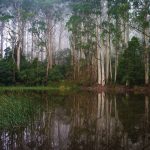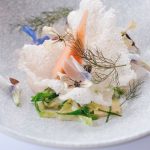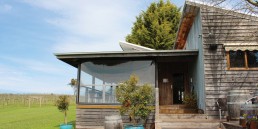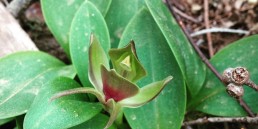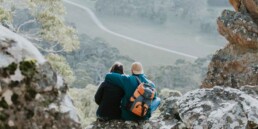Ngannelong was a sacred place for ceremonies, meditations, and initiations for at least 26,000 years
In a former life, I had a job that meant I spent a lot of time at Uluru Kata Tjuta National Park…and even more time in Kakadu National Park, having lived there for a year. It was a great honour to work in these iconic places and now I have the honour of working in a region that’s home to Hanging Rock…also known as Mount Diogenes…and before that, Ngannelong…or Anneyelong.
The very name of this famous site raises all sort of questions. For starters, should we start using the indigenous name for this site, as has happened at Uluru and many other sites around Australia? The answer, in my view, is ‘yes’ but it also raises further questions. For starters, there is some conjecture as to the actual indigenous name of the site. A German naturalist created an engraving of the rock in the mid-1850’s using the word ‘Anneyelong’ but toponymists believe that he misheard the name and it’s actually ‘Ngannelong’. No one is sure.
One of the challenges facing anthropologists, historians and, indeed the various traditional owner groups around Australia, is that indigenous stories were passed on verbally – there was no written indigenous language here. This would have been fine; after all this culture stretches back tens of thousands of years and was travelling along perfectly well until white people showed up. The cataclysmic impact of European settlement on the indigenous people and culture is well known. One of the many tragic outcomes of the upheaval was that many of the rich cultural stories have been lost, or are in danger of being lost, for ever.

So, when I was asked to write an article on the indigenous history of ‘the rock’, I was surprised at the lack of available information. What we do know is this: the site – let’s call it Ngannelong – is located near the traditional boundary between three Aboriginal tribal groups – the Woi Wurrung (Wurundjeri), the Dja Dja Wurrung and the Taungurung. Each has its own perspectives and stories, but evidence suggests that the group were highly inter-connected and it is clear that Ngannelong was a sacred place for all three groups and was used for ceremonies, meditations, and initiations for at least 26,000 years…possibly more like 40,000.
Archaeologists have unearthed stone tools dating back at least 10,000 years at the site. The sources of the stone used to make tools found at Hanging Rock come from a considerable distance, suggesting that Ngannelong was the site of a much larger social and economic network. There is also a natural spring that provided a valuable source of water.
As a prominent culturally significant landmark near tribal boundaries, the rock is likely to have been used for Ngargee ceremonies (Corroborrees) and other traditional business that involved gatherings between the three groups for marriages, resolution of conflicts, trade and initiation.
When you consider that the three traditional owner groups have been visiting the site since at least the last ice age, it puts into perspective the importance of Ngannelong as a part of indigenous history. It also gives us some perspective into the remarkable longevity of the Australian Aboriginal culture. Jesus was born a couple of thousand years ago. The pyramids were built 5,000 years ago. At least 25,000 years ago indigenous people were performing ceremonies at what we have been calling ‘Hanging Rock’ for a few decades.
Next time I visit Hanging Rock/Ngannelong (we take our kids there often), I’ll stop to take a moment to reflect on this, I encourage you to do the same.
About the author

Steve Wroe, Daylesford Macedon Tourism
Steve’s passion for mountain biking takes him all around our region. He lives in Daylesford with his wife, two young girls and three chickens. On most weekends, he and his family explore; either piling into the car and taking a drive to a small town, or putting on the hiking boots and going for a bushwalk. Steve is a big believer in the benefits of rural living and loves introducing his girls to the history, culture and nature of the region. Occasionally they take their bantam chook, Lulu, on their adventures.
-
Steve Wroe, Daylesford Macedon Tourismhttps://daylesfordmacedonlife.com.au/author/steve-wroe-daylesford-macedon-tourism/November 20, 2018
-
Steve Wroe, Daylesford Macedon Tourismhttps://daylesfordmacedonlife.com.au/author/steve-wroe-daylesford-macedon-tourism/November 5, 2019
-
Steve Wroe, Daylesford Macedon Tourismhttps://daylesfordmacedonlife.com.au/author/steve-wroe-daylesford-macedon-tourism/February 28, 2020
Share this article
While You're Here
The Real Stars of the Screen
There’s unrivalled beauty in the natural landscapes, architecture, forests and rural streetscapes…
Taste of Talbot
The goldfields town of Talbot is renowned for its monthly farmers’ market. On the third Sunday of…
Blampied Village
First settled around the 1860s, the place known as Blampied epitomises the ‘blink and you miss it’…
Best Short Walks
Need a natural health kick? Since the late 1800s people have visited the Daylesford and Macedon…
Interview with Charles Dickie – Lerderderg State Park
Charles Dickie has been a Park Ranger for thirty-seven years and currently has Lerderderg State…
What To Do For Under $50
So, this inflation thing… is a thing. The increasing cost of living (and enjoying your life) means…


